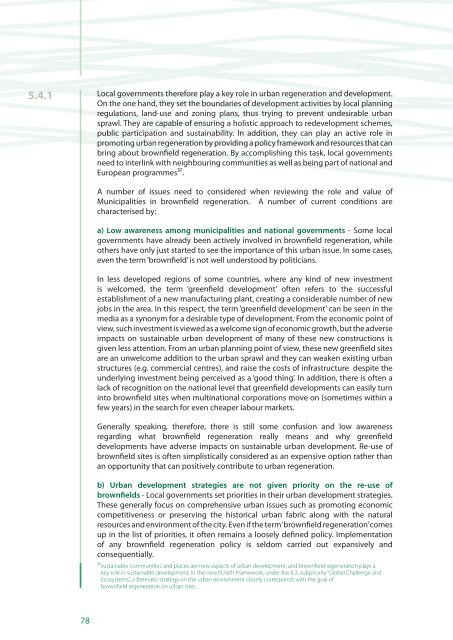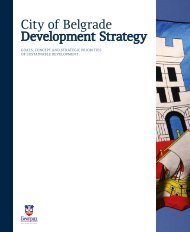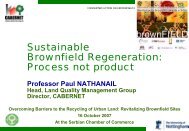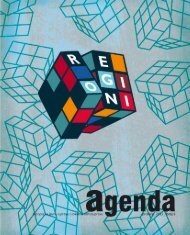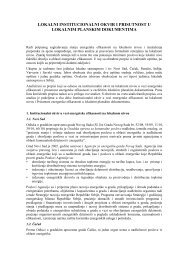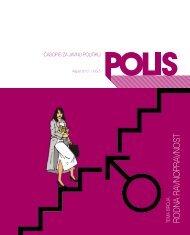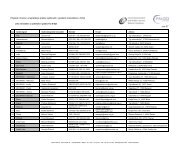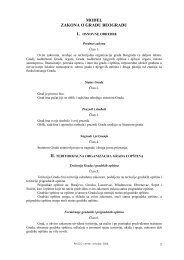Sustainable Brownfield Regeneration: CABERNET Network Report
Sustainable Brownfield Regeneration: CABERNET Network Report
Sustainable Brownfield Regeneration: CABERNET Network Report
You also want an ePaper? Increase the reach of your titles
YUMPU automatically turns print PDFs into web optimized ePapers that Google loves.
5.4.1Local governments therefore play a key role in urban regeneration and development.On the one hand, they set the boundaries of development activities by local planningregulations, land-use and zoning plans, thus trying to prevent undesirable urbansprawl. They are capable of ensuring a holistic approach to redevelopment schemes,public participation and sustainability. In addition, they can play an active role inpromoting urban regeneration by providing a policy framework and resources that canbring about brownfield regeneration. By accomplishing this task, local governmentsneed to interlink with neighbouring communities as well as being part of national andEuropean programmes³⁷.A number of issues need to considered when reviewing the role and value ofMunicipalities in brownfield regeneration. A number of current conditions arecharacterised by:a) Low awareness among municipalities and national governments - Some localgovernments have already been actively involved in brownfield regeneration, whileothers have only just started to see the importance of this urban issue. In some cases,even the term ‘brownfield’ is not well understood by politicians.In less developed regions of some countries, where any kind of new investmentis welcomed, the term ‘greenfield development’ often refers to the successfulestablishment of a new manufacturing plant, creating a considerable number of newjobs in the area. In this respect, the term ‘greenfield development’ can be seen in themedia as a synonym for a desirable type of development. From the economic point ofview, such investment is viewed as a welcome sign of economic growth, but the adverseimpacts on sustainable urban development of many of these new constructions isgiven less attention. From an urban planning point of view, these new greenfield sitesare an unwelcome addition to the urban sprawl and they can weaken existing urbanstructures (e.g. commercial centres), and raise the costs of infrastructure despite theunderlying investment being perceived as a ‘good thing’. In addition, there is often alack of recognition on the national level that greenfield developments can easily turninto brownfield sites when multinational corporations move on (sometimes within afew years) in the search for even cheaper labour markets.Generally speaking, therefore, there is still some confusion and low awarenessregarding what brownfield regeneration really means and why greenfielddevelopments have adverse impacts on sustainable urban development. Re-use ofbrownfield sites is often simplistically considered as an expensive option rather thanan opportunity that can positively contribute to urban regeneration.b) Urban development strategies are not given priority on the re-use ofbrownfields - Local governments set priorities in their urban development strategies.These generally focus on comprehensive urban issues such as promoting economiccompetitiveness or preserving the historical urban fabric along with the naturalresources and environment of the city. Even if the term ‘brownfield regeneration’ comesup in the list of priorities, it often remains a loosely defined policy. Implementationof any brownfield regeneration policy is seldom carried out expansively andconsequentially.³⁷<strong>Sustainable</strong> communities and places are new aspects of urban development, and brownfield regeneration plays akey role in sustainable development. In the new EU 6th Framework, under the 6.3. subpriority “Global Challenge andEcosystems”, a thematic strategy on the urban environment closely corresponds with the goal ofbrownfield regeneration on urban sites.78


